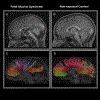Clinical presentation, diagnosis, and management of fetal alcohol spectrum disorder
- PMID: 31160204
- PMCID: PMC6995665
- DOI: 10.1016/S1474-4422(19)30150-4
Clinical presentation, diagnosis, and management of fetal alcohol spectrum disorder
Abstract
Although prenatal alcohol exposure causes craniofacial anomalies, growth retardation, neurological abnormalities, cognitive impairment, and birth defects, fetal alcohol spectrum disorder is underdiagnosed. Global prevalence of fetal alcohol spectrum disorder is 0·77%, with a higher prevalence of 2-5% in Europe and North America, highlighting the need for increased diagnosis and treatment. However, diagnosis remains challenging because of the poor reliability of self-reported maternal drinking histories, an absence of sensitive biomarkers, and the infrequency of diagnostic dysmorphic facial features among individuals with fetal alcohol spectrum disorder. Different diagnostic systems and disagreements over criteria have slowed progress in the diagnosis and management of the disorder. Neuroimaging shows abnormalities in brain structure, cortical development, white matter microstructure, and functional connectivity in individuals with fetal alcohol spectrum disorder. These abnormalities modify developmental trajectories and are associated with deficits in cognition, executive function, memory, vision, hearing, motor skills, behaviour, and social adaptation. Promising trials of nutritional interventions and cognitive rehabilitation therapies are underway, with the aim of treating cognitive deficits in fetal alcohol spectrum disorders.
Copyright © 2019 Elsevier Ltd. All rights reserved.
Conflict of interest statement
Declaration of interests
Figures

References
-
- Rangmar J, Hjern A, Vinnerljung B, Stromland K, Aronson M, Fahlke C. Psychosocial outcomes of fetal alcohol syndrome in adulthood. Pediatrics 2015; 135(1): e52–8. - PubMed
-
- Parnell SE, Riley EP, Warren KR, Mitchell KT, Charness ME. The contributions of Dr. Kathleen K. Sulik to fetal alcohol spectrum disorders research and prevention. Alcohol 2018; 69: 15–24. - PubMed
Publication types
MeSH terms
Grants and funding
LinkOut - more resources
Full Text Sources
Other Literature Sources
Medical

